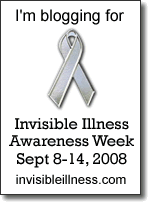 RSS FEED
RSS FEED
Can You See my Pain? Can I See my Pain?
September 8th, 2008
It’s Invisible Illness Awareness Week, a worldwide effort to bring together people who live with invisible  chronic illness and those who love them.
chronic illness and those who love them.
According to the Invisible Illness Blog, nearly 1 in 2 Americans have some kind of chronic illness. From heart disease to mental illnesses, cancer, lupus, chronic fatigue, Migraine and headache disorders and many others, people are suffering all around. While our illnesses may be invisible, giving no outward visual signs, why are they so unknown to those around us?
The statistics on Migraine disease are staggering.
- About 12% of the human population has Migraine disease (at any given time). That’s about 1 out of every 8 people you know.
- About 20% of the human population will have Migraine disease at some time in their lifetime (since it may develop in childhood, adolescence or adulthood, and since it sometimes fades or disappears with age). That’s about 1 out of every 5 people you know!
- About 47% of Migraineurs have 3 or more Migraine attacks per month. That’s about 1 out of every 17 people you know!
Given those numbers, why is this disease so misunderstood, un-researched, underfunded, and the treatment options so undeveloped? Why do so many people, even doctors, think it’s “just a headache”? There’s enough for several more posts in answer to that question, but I think invisibility is one of the major reasons.
 Think about the invisibility of head pain. Unless someone is highly attuned to changes in our eyes and expressions, or the cue of hand to forehead, they will not know when we have a Migraine attack. It’s not like they can see the hammer knocking us on the head! Even more significantly, perhaps, it’s hard for others to understand how we might feel fine today, but be unable to get out of bed tomorrow. It’s hard to understand the long term consequences of frequent or chronic pain. Migraine can increase stroke risk, and Migraine disease can cause brain damage over time: this is recent knowledge.
Think about the invisibility of head pain. Unless someone is highly attuned to changes in our eyes and expressions, or the cue of hand to forehead, they will not know when we have a Migraine attack. It’s not like they can see the hammer knocking us on the head! Even more significantly, perhaps, it’s hard for others to understand how we might feel fine today, but be unable to get out of bed tomorrow. It’s hard to understand the long term consequences of frequent or chronic pain. Migraine can increase stroke risk, and Migraine disease can cause brain damage over time: this is recent knowledge.
There is much we can do to educate others, to explain to those around us, to rally for more research, to insist on accommodations at work and adequate treatment from doctors, emergency rooms, and insurance companies. But I think one foundation of the problem lies in how invisible this illness even to ourselves.
Last week I practiced saying “I am chronically ill.” I said it to a number of different people, and told it to myself in the mirror. Big deal? It is a big deal. It is the reality of my life for most of the last 13 years, yet I have a very hard time accepting it. I am a meticulous record keeper. I keep a very detailed Migraine and Wellness diary where I track not only Migraines but my sinus infections, my fatigue, and my dizziness, among other things. I can tell you that over the past 4 years, I have been sick, with my ability to function significantly reduced, 25% of the time. It’s probably higher than that, because I have a lot of Migraines in the evening, but if I have worked and functioned most of the day, I have counted that as a well day.
I am one of the lucky ones. Many chronically ill people are sick more than half the time. Since I am in business for myself, I can set my work up to be flexible and take the time I need for myself. My ability to meet deadlines and my income do suffer. Imagine having a job, and needing to take 6 sick days per month. That’s what my numbers translate to.
Those are the facts, and yet it is very hard to accept that I am chronically ill. If you’re not sick every day, it’s easy to fall into denial again. To forget that there are limitations to what I can do. That even when I feel great I need to be very cautious and marshal my energy. That things I used to do are not
available to me any more. That I need to adjust the standards I have measured myself by.
I need to be as kind, forbearing, patient, understanding and loving towards myself as I would be to a friend who was chronically ill. Why is that so hard? I need to accept where I am without giving up hope, and while still striving to take better care of myself, get better treatment, do everything I can to be as well as I can be.
When I am caring for myself in this way (and I do manage it at times), it is easier for me to be real with the people around me. To explain my illness, to help them understand. I need to have my illness visible to me; then I can help make it visible to others.
– Megan Oltman
Tags: chronic illness, invisible illness, migraine
Posted in Advocacy, Communicating, Managing | Comments (2)
That disclaimer thing...
Remember: nothing we do here is medical advice or treatment or is a substitute for medical advice or treatment. Get competent medical advice to learn more about your migraines, possible treatments and risks.
What's New on Migraine Support Group Coaching |
Recent Comments
- on Calling all Redheaded Migraineurs
- on No, You’re not Crazy, You just Have Migraines
- on No, You’re not Crazy, You just Have Migraines